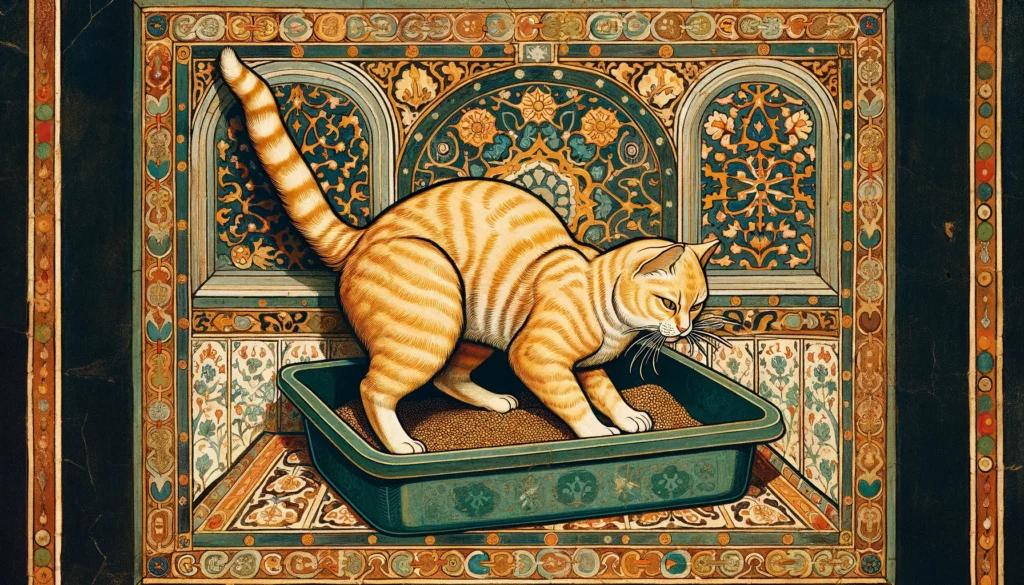Cats dig in their litter boxes for various reasons, reflecting their instinctual behaviors and personal needs. Here, we’ll explore the question “why do cats dig in the litter box” and uncover the motivations behind this common feline behavior.
Cats do this not just out of habit, but for reasons deeply rooted in their nature. From marking their territory to ensuring their space is clean, these behaviors are a window into the feline world.
- Key Takeaways
- 1. The Instinctual Behavior Behind Litter Box Digging
- 2. Covering Waste: More Than Cleanliness
- 3. Behavioral Insights: Marking Territory and Environmental Checks
- 4. Personal Preferences and Stress Responses
- 5. Health Issues and Educational Moments
- FAQ: Understanding Cat Behavior in Litter Boxes
- Further Reading
- Unraveling the Mystery: Final Thoughts on Feline Litter Box Habits
Key Takeaways
- Instinctual and Learned Behaviors: Cats’ digging actions are deeply rooted in their survival instincts and adapted through their domestication. Recognizing these as natural and necessary behaviors can help us create a more comfortable and stimulating environment for them.
- Health Monitoring: Changes in litter box behavior, especially digging, can be early indicators of health issues, such as urinary tract infections (UTIs). Monitoring these behaviors closely allows for prompt veterinary care, ensuring our cats maintain optimal health.
- Personal Preferences: Each cat has unique preferences regarding the texture and depth of their litter. Catering to these preferences can significantly impact their litter box usage and overall satisfaction.
- Stress and Anxiety: Excessive or altered digging habits can signal stress or anxiety in cats, often triggered by environmental changes. Being mindful of these signs can help us address and mitigate their stressors effectively.
- Educational and Developmental Roles: The behaviors demonstrated by mother cats and observed by their kittens serve as crucial learning moments, emphasizing the importance of natural learning processes in feline development.
You may also like – Understanding Cat Behavior: Litter Box Scratching Explained
1. The Instinctual Behavior Behind Litter Box Digging
Digging is an innate behavior for cats, deeply rooted in their survival instincts. This unique activity isn’t solely for amusement; it’s a vital part of their litter box habits, ensuring their environment remains sanitary and secure.
- Cats carve out a private nook within their litter for safety.
- This behavior stems from a primal urge to ward off potential threats.
- By burying their waste, they maintain the cleanliness of their territory.
Understanding Why Cats Bury
In natural settings, cats hide their waste to camouflage their presence from predators, treating it as a covert strategy to stay undetected.
- Concealing waste serves as a cat’s tactic for stealth, avoiding predators.
- This action ensures their habitat remains inconspicuous to adversaries.
- It’s a survival technique inherited from their ancestors, crucial for their wellbeing.
The Natural Digging Instinct of Cats
Domestic cats maintain the impulse to dig and cover, pivotal for their well-being and tidiness, despite being safe indoors.
- Indoor felines adhere to these instinctual practices, akin to their outdoor counterparts.
- The ritual is geared towards sustaining personal hygiene and comfort.
- This ingrained behavior is a tribute to their wild lineage, keeping them alert and prepared.
2. Covering Waste: More Than Cleanliness
Covering waste is not merely about cleanliness; it’s a complex behavior stemming from a cat’s natural tendencies. This process is intertwined with their instinctual drive for hygiene and safety, far beyond simple tidiness.
- This action is part of a hygienic practice to prevent the spread of odors and disease.
- It’s an instinctive method to ensure their living area remains unpolluted.
- Covering up also signifies a respect for their environment, maintaining a balance in their immediate surroundings.
Litter Box Cleanliness and Safety
By covering their waste, cats naturally minimize odors and maintain a clean living environment. This sanitation effort is crucial in creating a hospitable habitat for themselves and their human companions.
- Reduces the risk of health issues by keeping areas germ-free.
- Ensures the litter box remains an appealing place for its intended use.
- Promotes a sense of well-being for both cats and their owners through cleanliness.
Scent Masking: A Protective Behavior
This act of covering waste serves to mask their scent from potential threats, a strategic move to stay invisible to predators and maintain territory.
- Conceals their presence, making them less likely to be targeted by predators.
- Acts as a defensive mechanism to protect against other animals.
- Preserves the peace within multi-cat households by minimizing conflict over territory.

3. Behavioral Insights: Marking Territory and Environmental Checks
Digging behaviors serve crucial roles in how cats perceive and interact with their environment. This aspect of their behavior is not just about cleanliness but also about communicating with their surroundings and establishing their presence.
- Acts as a way to assert dominance and claim space in multi-cat households.
- Environmental interaction is key to their mental well-being and comfort.
- Through digging, cats can evaluate the safety and quality of their litter, ensuring it meets their standards.
How Cats Use Litter Boxes to Mark Territory
Digging allows cats to leave their unique scent, marking their territory. This natural scent marking is a silent yet powerful way to communicate their ownership over a space.
- Scent glands in their paws leave a personal signature on their environment.
- This behavior strengthens their sense of security and personal space.
- It’s a non-verbal communication method with other animals, signaling “this is mine.”
Checking the Environment: A Pre-Use Ritual
Cats often dig to assess the cleanliness and suitability of the litter box. This pre-use ritual is a critical aspect of their litter box behavior, reflecting their meticulous nature.
- Ensures the litter box is up to their hygiene standards before use.
- Allows them to detect any changes in their environment that might affect their comfort.
- This investigative behavior showcases their adaptability and intelligence.
4. Personal Preferences and Stress Responses
A cat’s litter box behavior is influenced by its personal preferences and emotional state. This variance highlights the importance of understanding and catering to individual needs to ensure their comfort and well-being.
- Preference varies widely among cats, affecting their litter box usage.
- Emotional well-being plays a significant role in their daily habits.
- Adjustments to their environment can significantly impact their stress levels and behavior.
Litter Box Preference: Texture and Depth
Cats show their preferences for litter texture and depth through their digging behavior. This choice is not random but a clear expression of their comfort and cleanliness standards.
- Selection based on texture influences their willingness to use the litter box.
- Depth preference can indicate their natural instincts for covering waste.
- Catering to these preferences can enhance their satisfaction and usage of the litter box.
Indicators of Stress or Anxiety in Digging
Excessive digging can be a sign of stress, triggered by changes in their surroundings. This behavior can serve as an important behavioral cue for cat owners to notice.
- Changes in digging habits may signal discomfort or anxiety.
- Environmental stressors, such as new pets or changes in the home, can increase digging.
- Monitoring and addressing these signs can help in reducing stress and promoting a healthy emotional state.

5. Health Issues and Educational Moments
At times, digging behaviors can indicate health concerns or act as teaching moments. Recognizing these patterns can help cat owners address potential issues early and understand the developmental aspects of kitten care.
- Health-related digging may require veterinary attention.
- Observational learning plays a key role in kitten development.
- Understanding these cues can strengthen the human-cat bond.\
When Digging Signals Urinary Health Concerns
Intense and frequent digging could point to health issues such as UTIs. This behavior is a crucial indicator that something might be amiss with your feline friend’s health.
- Urinary problems often manifest through litter box behaviors.
- Early detection and treatment are vital for urinary health.
- Regular vet check-ups can preempt potential health complications.
Teaching Kittens: The Role of Mother Cats
Watching mother cats teach their kittens the art of using a litter box sheds light on the importance of these behaviors. This natural process highlights the instinctual drive to maintain cleanliness and order.
- Kitten training by mother cats is essential for learning proper litter box use.
- These moments are pivotal for social and survival skills development.
- Human interaction should support, not disrupt, this natural learning process.
FAQ: Understanding Cat Behavior in Litter Boxes
Q: Why Do Cats Engage in Excessive Litter Box Digging?
A: Cats often engage in excessive digging in their litter boxes as part of their instinctive behavior. This behavior can be linked to their natural instincts to bury their waste to avoid attracting predators and to keep their territory clean. Additionally, excessive digging might indicate that the cat is trying to create a comfortable and clean area to relieve themselves.
Q: What Causes Cats to Dig in Their Litter Box Before Eliminating Waste?
A: Cats dig in their litter before eliminating waste as a pre-elimination ritual. This behavior is instinctual, stemming from their wild ancestors’ need to hide their scent from predators and rivals. By digging, cats are preparing a spot to cover their waste effectively after they are done, which helps mask their presence in their environment.
Q: Why Do Cats Scratch the Floor Around Their Litter Box?
A: Cats may scratch the floor around their litter box as an extension of their instinct to bury their waste. Even though domesticated, cats retain many behaviors from their wild ancestors, including the need to cover their tracks for safety reasons. Floor scratching might also indicate the cat’s dissatisfaction with the cleanliness or type of litter in the box.
Q: What Triggers a Cat to Dig More Than Usual in Their Litter Box?
A: A cat may dig more than usual in their litter box due to various reasons, including discomfort or dissatisfaction with the litter, the cleanliness of the box, or even health issues. If the digging seems excessive or is accompanied by other unusual behaviors, it’s advisable to consult a veterinarian to rule out any medical concerns.
Further Reading
Why Cats Scratch, Dig & Play in Their Litter Box
Why Do Cats Dig In Their Litter Box?
Understanding and Addressing Cat Digging in the Litter Box
Unraveling the Mystery: Final Thoughts on Feline Litter Box Habits
Grasping “why do cats dig in litter boxes” helps us understand their complex behaviors and meet their needs more effectively. This exploration into the reasons why cats engage in digging behaviors in their litter boxes illuminates the nuanced nature of their instinctual and learned actions. By examining each of the eight reasons, we’ve offered a comprehensive look into the world of feline behavior, emphasizing the importance of understanding these actions from both a health and behavioral standpoint.


